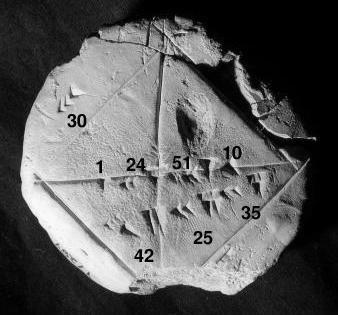CS173: History of Computing
Bill Mongan
Mechanical Computing Machines
- The abacus (base-60 calculator), c. 2700 BCE [1]
- Arithmetic operations
Mechanical Computing Machines
- Antikythera Mechanism (astronomy), c. 100 BCE [2]
- Gearing represented periodic functions for celestial bodies
Number Systems
- Why might the early abacus have used a base-60 system?
- What other systems do we know?
- What is the simplest number system?
- Why can’t we represent this number more precisely?
Number Systems
- Babylonian number system showing fractional portions of base 60 units to represent an approximation of the square root of 2 (24, 51, and 10 are are the numerators of each fractional place value added to the unit value 1)
Logic
- Godfried Leibniz (1689) proposed a binary number system, derived from the I Ching (based on yin and yang) [3]
- George Boole (1847): The Mathematical Analysis of Logic - used a binary system to propose Boolean Algebra (AND, OR, NOT)
- Tent: Warm AND NOT Raining
Logic
- Claude Shannon (1937) applied binary to circuits
- This led to the publication of his The Mathematical Theory of Communication (1948), giving rise to modern Information Theory and digital communications
- Coined the term “bit”
- Joseph Jacquard’s Loom (1801): textile weaving from binary codes encoded on punch cards [4]
The Analytical Engine
-
Charles Babbage (1837) proposed the Analytical Engine - a design for a modern computer using punch cards [5]
-
Ada Lovelace proposed the first Algorithm to compute the sequence of Bernoulli Numbers to be executed on the Analytical Engine
- The engine was not completed during her lifetime, so it could not be executed, but this was the first computer program [6]
Turing Machines
- Church-Turing Thesis (1936): mathematical representation of a “function” that must be expressed in small, basic steps that could be carried out mechanically [7]
- It doesn’t matter if the steps are so tedious that the process would take a long time, because we can eventually use this model to automate the process with fast computers
Turing Machines
- Turing Machine: a theoretical mechanism that can carry out computations using binary and simple read/write/shift instructions on a tape
- The Algorithm (Muhammad ibn Musa al-Khwarizimi, c. 800 CE) [8]
- Derived from his book on Algebra as a definition of a process
- Used to define the process of steps undertaken by a Turing Machine
The First Computer “Bug” (1945)
Modern Computer Architectures
- John Von Neumann Architecture (1946)
- Arithmetic, Conditionals, Branches, Loops
- Single bus for unified instruction and data memory, using registers to bridge the gap
Modern Computer Architectures
- Harvard Architecture
- Instruction and data memory are separated for simultaneous access
Modern Computer Architectures
- Reduced Instruction Set Computer (RISC): short, consistent clock cycles
- CISC instructions encode more meaning into each larger instruction





